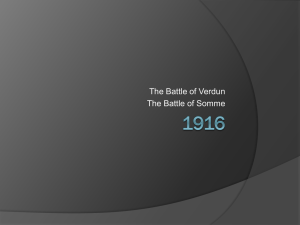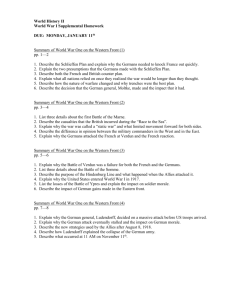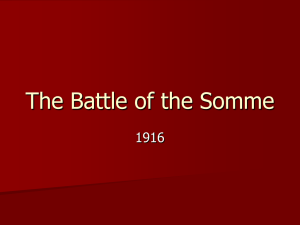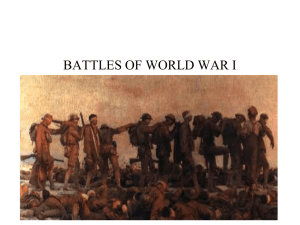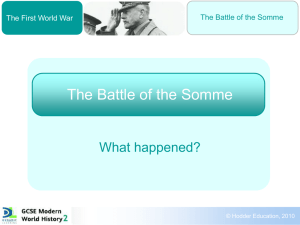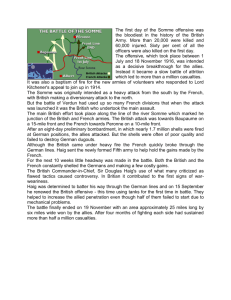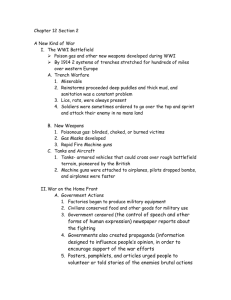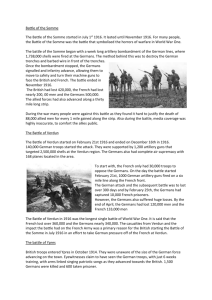WWI Battles US Enters the War
advertisement
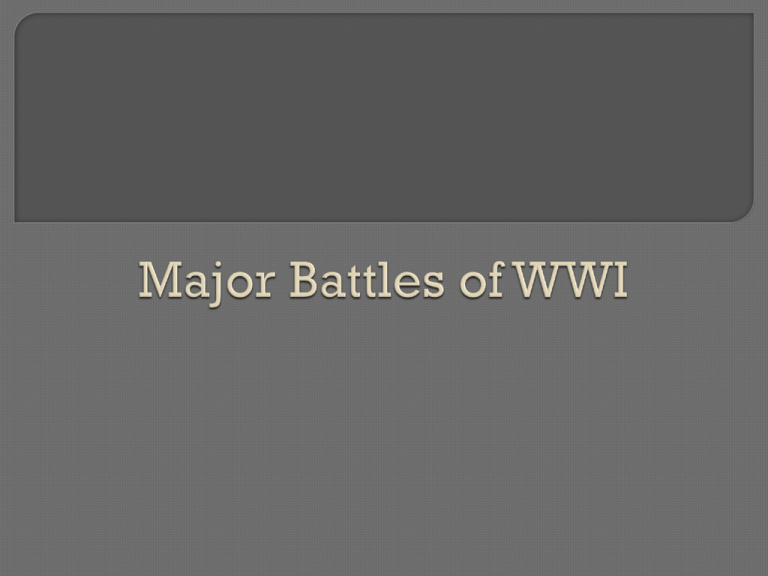
The First Battle of the Marne • The German army quickly advanced through northern France and after only one month of fighting were barely 25 miles from Paris. The French, however, would not give up. The Battle • The French launched a counterattack along the Marne River east of Paris on September 7, 1914. • This battle became known as the First Battle of the Marne. • 2 million men fought on a battle-front that stretched 125 miles. • After five days and 250,000 deaths, the French had rallied and pushed the Germans back some 40 miles. The Aftermath • The French paid a heavy price, as countless redcoated French troops had fallen in the battle. • Despite the loss of life, it helped the Allies by giving Russia more time to mobilize for war. • Once Russia mobilized, Germany had to pull some of its troops out of France and send them to fight Russia on the Eastern Front, which stretched from the Black Sea to the Baltic Sea. The Second Battle of Ypres involved four battles around Ypres. The first of these four battles began on 22 April 1915 as a surprise offensive by the German 4th Army on the Allied front line. This attack saw the first use of a new German weapon on the Western Front: poisonous gas. A breeze moving towards French troops carried the deadly gas. It had a devastating effect on the French and the German infantry made a significant advance into Allied territory. During the next four weeks the Allied Forces of Belgium, France and Britain fought to hold off the successful German advance and to regain the ground that had been lost north of Ypres. The fourth battle ended on 25 May 1915. Ypres The Allies had planned to launch a joint French and British assault in the region of the Somme. The target date was the middle of 1916. However, in February the Allied plan was upset when the Germans began an assault on the fortress-ringed city of Verdun. The belief was that Verdun was essential to the French that France would fight to the death. On February 21, the German artillery barrage began and, for the next several months both sides unleashed soldiers and shells at each By Christmas, when the battle finally ended, 800,000 men had lost their lives. One hundred and twenty-five miles northwest of Verdun, the British and French armies joined at the Somme river. A French-British offensive was planned here for 1916 to relieve pressure on the French at Verdun. Verdun, at beginning of Battle French troops awaiting order to advance Verdun, 1916 Verdun Verdun Verdun Verdun Verdun Before and after-Verdon Before and After During this horrendous fighting, the French sent frantic appeals to Sir Douglas Haig, the new British commander, to hasten the Somme offensive and to take the pressure off Verdun. Crater at beginning of Somme caused by 27 tons of explosive Left: These are typical battlefield scenes. Right: This photograph is a before and after look at Menin Road, located at Ypres. The top picture was taken in 1914, and the bottom was taken in 1918 after the "Battle of Ypres". Photos: Courtesy Queen’s University Archives Approximately 620,000 Canadians served in the Canadian Expeditionary Force, including 425,000 who served overseas; more than 60,000 were killed and 172,000 wounded, an enormous number for a small nation. Canadian military cemeteries overseas, carefully maintained by the Commonwealth War Graves Commission, graphically convey the scale of this loss. Canada was still a colony in 1914, but battlefield successes stimulated a desire among Canadians for greater national autonomy and international recognition. In 1919, Canada signed the Treaty of Versailles, which formally ended the war, and joined the newly-created League of Nations as a member state in its own right. Canada had come of age. Russian army moved into Eastern Germany on August 30, 1914 • Defeated Much more mobile more than the West • But loss of life still very high • 1915: 2.5 million Russians killed, captured, or wounded Germany and Austria Hungary joined by Bulgaria in Sept. 1915 • Attacked and eliminated Serbia from war The Gallipoli Disaster, 1915 Battlefield Detectives T. E. Lawrence & the “Arab Revolt”, 1916-18 Liaison officer to join the Great Arab Revolt, led by Prince Feisal. He took money and guns and helped keep the Revolt alive. Arab’s won even Turkish soldiers of the Ottoman Empire were more technologically advanced The Tsar with General Brusilov Brusilv Offense •As a counter to the Battle of Verdun. France persuaded Russia to launch a dual-wing attack. •20,000 German losses •70-100,000 Russian losses •Lowered an already hampered Russian morale. Famine across Russia as resources were being sent to the war effort. •However weakened the Central Powers and destroyed Austria-Hungary. •Unable to cope with loss of life and funds. Fighting in Africa British Sikh Mountain Gunners Black Soldiers in the German Schutztruppen [German E. Africa] Fighting in Africa 3rd British Battalion, Nigerian Brigade Fighting in Salonika, Greece •In Greece, the situation was rather complicated. The prime minister, Eleftherios Venizelos, argued that Greece should enter the war on the side of the Triple Entente. King Constantine, whose wife was German, insisted that Greece should stay neutral and avoid entering the war, something that would help the Central Powers. French colonial marine infantry from Cochin, China - 1916 •On 11th June 1917 Constantine abdicated and left the country. The throne was taken by his son Alexander, who agreed to work with Venizelos. Eleftherios Venizelos, returned to Athens to form a government and on 29th June 1917, declared war against the Central Powers. By July 1918 the Greek Army had 250,000 men fighting in Macedonia.
